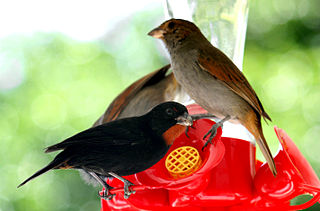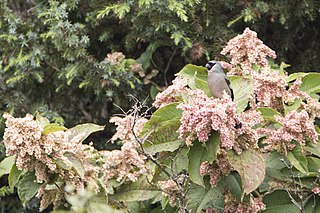
The Eurasian bullfinch, common bullfinch or bullfinch is a small passerine bird in the finch family, Fringillidae. In Anglophone Europe it is known simply as the bullfinch, as it is the original bird to bear the name bullfinch.

The pine grosbeak is a large member of the true finch family, Fringillidae. It is the only species in the genus Pinicola. It is found in coniferous woods across Alaska, the western mountains of the United States, Canada, and in subarctic Fennoscandia and across the Palearctic to Siberia. The species is a frugivore, especially in winter, favoring small fruits, such as rowans. With fruit-crop abundance varying from year to year, pine grosbeak is one of many subarctic-resident bird species that exhibit irruptive behavior. In irruption years, individuals can move long distances in search of suitable food supplies, bringing them farther south and/or downslope than is typical of years with large fruit crops.

Pyrrhula is a small genus of passerine birds, commonly called bullfinches, belonging to the finch family (Fringillidae). The genus has a Palearctic distribution; almost all species occur in Asia, with two species exclusively in the Himalayas and one species, P. pyrrhula, also occurring in Europe. The Azores bullfinch is a critically endangered species, occurring only in the east of the island of São Miguel in the Azores archipelago.

The Azores bullfinch, also known as the São Miguel bullfinch, or locally in Portuguese as the priolo, is a threatened passerine bird in the true finch family. It is endemic to São Miguel Island, in the Azores archipelago of Macaronesia in the North Atlantic Ocean.

The British finches are made up of several species of finch which were formerly very popular as cage birds in Great Britain. They are not currently commonplace, but are still kept by a few dedicated fanciers.
Bullfinch is a name given to two groups of passerine birds.
Captain Robert Cecil Beavan, corresponding member of the Zoological Society of London, served in India with the Bengal Staff Corps for 10 years. During his short life he collected specimens of birds and eggs at various locations. He contributed notes to the Ibis journal as wells as the Proceedings of the Zoological Society of London. He also collaborated with Allan Octavian Hume. His collection of eggs and birds went into the Natural History Museum through the Tweeddale and Godman-Salvin collections.

The orange bullfinch is a species of finch in the family Fringillidae. It is found in India and Pakistan. Its natural habitat is temperate forests.

The red-headed bullfinch is a species of finch in the family Fringillidae, found all across the Himalayas and adjacent highlands. It is found in Bhutan, northern India, Nepal and adjacent southern Tibet. Its natural habitat is temperate forests.

The white-cheeked bullfinch is a species of finch in the family Fringillidae.

The brown bullfinch is a species of bird in the true finch family, Fringillidae. It is found in Bhutan, China, India, Malaysia, Myanmar, Nepal, Pakistan, Taiwan, and Vietnam. Its natural habitats are temperate forest and subtropical or tropical moist montane forest.

The lesser Antillean bullfinch is a species of bird in the family Thraupidae. It is found in Saint Barth, Saint Martin, Anguilla, Antigua and Barbuda, Dominica, Grenada, Guadeloupe, Martinique, Montserrat, Netherlands Antilles, Saint Kitts and Nevis, Saint Lucia, Saint Vincent and the Grenadines, the British Virgin Islands, and the U.S. Virgin Islands.

Lesson's seedeater is a bird species in the family Thraupidae.

The Barbados bullfinch is a seedeater bird that is found only on the Caribbean island-nation of Barbados, where it is the only endemic bird species.
Conspectus of the Ornithological Fauna of the USSR (ISBN 5-02-005300-7) is a 1991 Russian language publication by ornithologist L. S. Stepanyan.

Prioksko-Terrasny Nature Biosphere Reserve is one of Russia's smallest zapovedniks, sprawling over an area of 5,000 hectares along the left bank of the Oka River in the Serpukhov District of Moskva Oblast. It was established in 1945 as part of the Moscow Nature Reserve and is home to 900 plant species, 130 bird species, and 54 mammal species. A wisent nursery was established in 1948 to populate the region with European bison from the Belovezhskaya Pushcha and Western Caucasus. There is also a small herd of American bison.

The Baikal bullfinch, also known as the grey bullfinch, grey-headed bullfinch or great bullfinch, is a small passerine bird in the finch family Fringillidae. It is found in eastern Kazakhstan, Mongolia and adjacent areas of Russia and China. Although sometimes considered a full species, most authorities treat it a subspecies of the Eurasian bullfinch. It migrates altitudinally from its summer breeding range in the Altai Mountains to its winter range in the adjacent foothills and plains.

The greater Azores bullfinch was a large, extinct species of bullfinch in the family Fringillidae that was once endemic to the Azores. It is the first known extinct passerine to be described from the islands. It is the largest known member of its genus based on its skull size, and had a very robust beak reminiscent of that of a parrot. However, the remains are otherwise reminiscent of the extant but highly endangered Azores bullfinch.

The Azores temperate mixed forests is a temperate broadleaf and mixed forests ecoregion of southwestern Europe. It encompasses the Azores archipelago in the Atlantic Ocean. These volcanic islands are an autonomous region of Portugal, and lie 1500 km west of the Portuguese mainland.

The Taiwan bullfinch is a species of finch in the family Fringillidae. It is endemic to the mountains of Taiwan. It was previously considered a subspecies of the grey-headed bullfinch and most authorities consider it as such, but a 2020 study found it to represent a distinct species that diverged from the mainland Asian P. erythaca during the mid-Pleistocene, and the International Ornithological Congress accepted it as such.



















